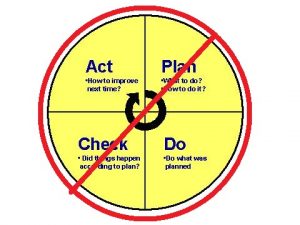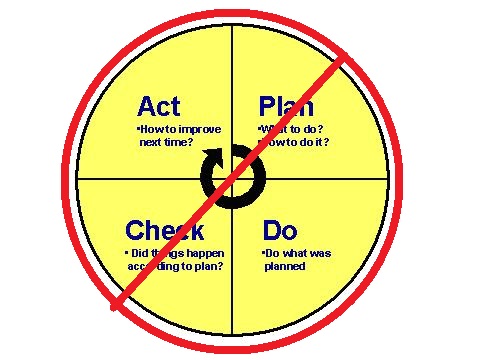
Author: Gregory M Carroll
PDCA is NOT Improvement Best Practice
There is a gaggle of Management Consultants pushing the 20th century mantra of Good Management Practice as a panacea to all the ill of today’s business environment. The key plank in most of these methodologies is that old chestnut “the PDCA cycle” for Continuous Improvement best practice. If your consultant wears this as a badge, run a mile!

Business Management is no longer just about Financial Accounting or Office Administration. Best Practice is not just someone’s vague opinion. Leading businesses from around the world have, thru the international standards organisation, put down a comprehensive set of guidelines for a broad range of ISO Systems Management areas covering management Best Practices.
Good Management Practice
Good Management Practice (GMP) is no more a key factor in business success than the Times Tables are in putting a man in space. It’s just a necessary interim first step. If you can afford to pay a consultant, you most likely are past that first step.
So what’s the difference between Good Management Practice and Best Practice?
Everyone is very familiar with the Plan-Do-Check-Act cycle that is the basis of today’s Good Management Practice. So what is the difference between Good Management Practice and Best Practice. Well do you realise the PDCA concept was first develop in the 1920’s by Walter Shewhart. Yes, it’s nearly 100 years old, and the business world has moved on considerably since the 1920’s. Best Practice in the 21st century is about getting a return and advancement out of your systems, not just doing it right. And by advancement I don’t mean incremental improvement but game changing leaps.
The graveyard of ex-successful businesses is littered with the bones of incremental improvement based businesses like Nokia, Blockbuster, Polaroid, and Pan Am. That’s not counting those at the precipice today, such as Hertz, Macy’s, CBS, Barnes Noble, and Kmart. Even Coca-Cola and IBM aren’t sure things anymore.
To survive in the 21st century, business needs to change its headspace. The odds are you wouldn’t be in business today (post GFC), if you hadn’t already implemented Good Management Practices. But my experience, in even leading businesses, is that they are often so bogged down in purely administrating their regulatory compliance. Due to that they don’t get to move into the area of improvement best practice.
So let me put it unequivocally, Improvement Best Practice is about focusing on:
The other ROI – Realisation, Optimisation, and Innovation.
I am not against PDCA, in fact it is the basis of modern scientific method. Realisation, Optimisation, and Innovation is an extension of PDCA. But that’s the point. Although PDCA is a good practice, ROI builds on PDCA to be a better practice and therefore PDCA is NOT Best Practice. Although I should more correctly refer to ROI as Better Practice, I will continue to use the term Best Practice. Undoubtedly there will be better practices in the future.
So let’s look at some specifics about each of the ROI concepts and where people can find more information on them.
Realisation
Even though the framers of ISO 9000 thought it important enough to allocate Product Realisation as a section in its own right, people still interpret it as Process Management. The definition of the word Realisation is “the achievement of something desired or anticipated” i.e. achievement not expectation. Realisation can only occurring in a real-time feedback loop scenario, otherwise it’s just a plan.
ISO9001:2015’s introduction of Risk is about modernising quality management practices from the traditional process based mentality to a more outcome focused framework. Realisation is about applying this “outcome focused“ aim to process management.
PDCA is a reactive sequential management process that provides a solution to a known issue. Realisation is about proactive concurrent parallel systems (yes a tautology) that gathers intelligence, identifies drivers or influences. It selects the best scenario to handle unexpected events and maximise outcomes. Those involved in integrated management system will quickly identify this as a risk eco-system.
Benefit Realisation, originally championed by the UK government, is widely accepted in project management as best practice. Instead of the traditional view of documenting processes and recording outputs, Realisation is about continual real-time monitoring with inbuilt mitigations along the lines of automatic fault detection and correction but applied to human interaction systems. The New South Wales government in Australia put out an excellent series of papers on its application as applied to Finance & Services. link here
Optimisation
Even without improvement, very few systems achieve their existing full potential. Efficient utilisation of time and resources (which is also an outcome of Realisation), and elimination of waste or excess is often easier and more rewarding than increasing throughput or performance, as it goes straight onto the bottom-line.
Quoting from Introduction to Process Optimisation (find here):
“Optimisation is a fundamental and frequently applied task for most engineering activities. However, in many cases, this task is done by trial and error (through case study). To avoid such tedious activities, we take a systematic approach to this task, which is as efficient as possible and also provides some guarantee that a better solution cannot be found. The systematic determination of optimal solutions leads to a large family of methods and algorithms. Moreover, the literature for Optimisation is dynamic, with hundreds of papers published every month in dozens of journals.”
As mentioned Optimisation acknowledges PDCA as a common method, but Process Optimisation seeks to provide “a better solution”. In principle it takes a mathematical modelling approach to identifying key influencing factors and their optimum values. Although the document quickly descends into technical examples, the 1st two sections I believe are reasonably easy to understand. It also refers to a number of modelling programs you can look at, so I can’t be accused of self-promotion.
Optimisation, being systematic requires subject matter expertise, which is probably why it is being shunned by “generalist” consultants. To assist those interested in pursuing Optimisation as a best practice, here’s a link to selection of books on Process Optimisation modelling in a wide range of specific subjects: see more…
Innovation
Innovation is synonymous with improvement best practice. There seems to be a miscomprehension that ISO9001 proscribes PDCA but Continuous Improvement encompasses both incremental and innovative improvement. Innovation is something new, not just incrementally improved. At the heart of innovation is creativity, inspiration and diversity, the antithesis of continuous improvement which is introspective. Where would Apple, Virgin or Dyson be today if they looked at the world from a “Continuous Improvement” perspective.
The debate between the practicality of incremental improvement verses the disruptive paradigm change of innovation, I will defer at this moment, as both have merit.
I believe innovation is widely avoided as a method of continuous improvement best practice due to a lack of understanding of its mechanics and the lack of an obvious framework. I have plans to do an article on my vision of an innovation management framework in the new year. The West Australia Dept of Agriculture has done some great work on combining the two into a single strategy they refer to as CI&I, Continuous Improvement and Innovation (see here).
At its heart Innovation is a cultural issue needing desire to propagate. The most succinct bit of advice on enabling innovation came from Charles Harary talking about Entrepreneurship, but it can easily be applied to developing Innovation within an existing business: “Ask for advice. Ask for connections. Ask for money. Be creative. Just ask, and you may just receive what you need.” (Read more..).
In Conclusion
Even though Best Practices are clearly mapped out in the gambit of ISO System Management standards, they are continually being dumbed down into 20th century failed practices.
Moving to 21st century best practices of Realisation, Optimisation and Innovation, the ISO standards would then be interpreted that:
- Asset Management is NOT just managing assets BUT realizing value out of assets.
- Organisational Resilience is NOT just about business continuity BUT leaving a legacy to those who follow.
- Risk Management is NOT just about reducing risk BUT reducing uncertainty on objectives.
- Supplier Management is NOT just about fiduciary duty BUT achieving the value for money promise.
- Occ Health & Safety is NOT just about regulatory compliance BUT securing a safe and healthy environment.
- Quality Management is NOT just getting it right BUT wowing the customer.
So why not take another look at those standards with a 21st century hat on and ask yourself: Are our systems really supporting us to be here in 20 years?


Pingback: Business Applications for Predictive Analytics • AI Insights
Pingback: How to develop an Innovation Culture - The Future of ERM